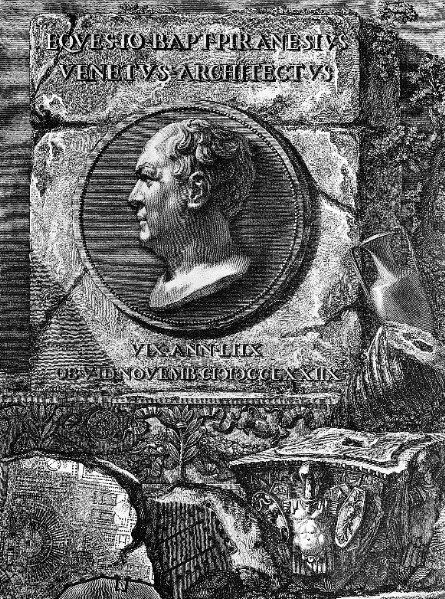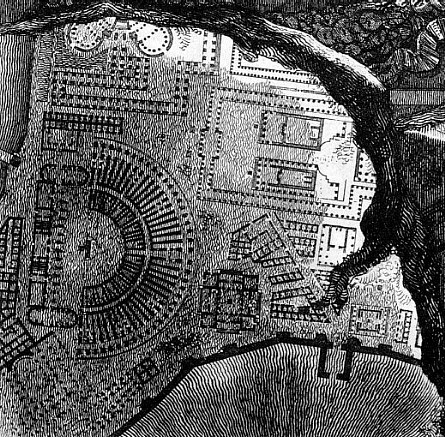insights regarding the Campo Marzio Busti
1998.04.27
...ideas regarding the Bustum Hadriani and the Bustum Caesaris Augusti. ...Piranesi treated them as opposites of each other.
...the radiation triangular clitoporticus of the Bustum Hadriani--a porticus dedicated to the evocation of the gods and the spirits of the lower world. Such a porticus fits perfectly on the axis of death, ...the meaning of the Bustum is burning place and there is the slab for the burning bodies and the funeral-pyre. The design of the clitoporticus directs all focus upon the place of burning, and it is easy to imagine the wailing that would emanate from this place--it is interesting to match the raising of wailing voices from the clitoporticus with the raising of smoke from the cavea bustum. The whole Bustum Hadriani is exceedingly morbid, and, ironically, it seems that the burning of the dead within the Bustum Hadriani is treated as a spectator sport, especially with the grandstands of the cavae bustum.
...in the Bustum Augusti there is the exact opposite wording--the joyful recollection of Augustus. ...all the other contrasts between the Bustum Hadriani and the Bustum Augusti:
...the Clitoporticus ab Hadriano funnels inward; the Nemus Caesarum fans outward.
...the Hadrian precinct is square, the Augustus precinct is round.
...the Bustum Hadriani is a depression; the Bustun Caesaris Augusti is raised on a hill.
...the center of the Bustum Hadriani is fire; the center of the Bustum Caesaris Augusti is water.
...the Bustum Hadriani is surrounded by a canal (moat); the Bustum Caesaris Augusti is surrounded by a wall.
...the Bustum Hadriani, with its circuses, is open to all; the Bustum Caesaris Augusti, with its iron gates, is closed.
...the Bustum Hadriani has some degree of archeological veracity; the Bustum Caesaris Augusti is full of blatant misplacements.
...Bustum Caesaris Augusti represents the "rise" of Rome, and the Bustum Hadriani represents the "fall" of Rome, ...another inversion derived from a whole set of inversions. The notion of "rise" can also be seen in the phallic porticus of the Bustum Caesaris Augusti.
Hadrian, Plotina, and Paulina Domitia, etc.
1998.06.02
According to the biography of Hadrian, he was a favorite of Plotina. In fact, there is some cause to believe that it was Plotina that got Hadrian named as sucessor at Trajan's deathbed. ...more symbolism along the axis of life.
Hadrian's birth mother's name was Paulina Domitia, and this fact lead to further speculation as to the meaning of the Sepulchra Familiae Domitorum at the end of the axis of death--the counter point of Hadrian's tomb. There is reference to both Hadrian's real mother and to his adoptive mother within the axes of life and death.
...sheds light on Piranesi's overall intention in (re-)designing (not reconstructing) the Campo Marzio. Piranesi was redrawing/redesigning the Campo Marzio, a redesign not at all capricious, but one based wholeheartedly on a vast amouint of historical facts. That is to say, Piranesi set out to improve the ancient Campo Marzio's "urban plan" without changing the region's existing program.
...reminded of Stirling's notion of evolutionary designing, and his statements about what could or should be considered when designing a house for K.F. Schinkel 200 years after Schinkel's birth. I am also reminded of Tafuri's wrongness in calling the Ichnographia of the Campo Marzio an "experimental design and therefore an unknown."
Piranesi operated on a few planes when generating his plan of the Campo Marzio--there is the redesigned plane, the Pagan-Christian narrative plane, and the plane of (composite?) temporal palimpsest. To make matters difficult, however, none of these planes complies completely with the other two, nor can any of the planes be viewed completely independent of the other two. In essence, Piranesi's (design) methodology emulates the very nature of Rome itself. The Ichnographia is a plan of many layers of meanings and messages which ultimately aptly represents Rome the city of many physical and historical layers.
As an archeologist, Piranesi "redraws" all the layers of Rome's ancient past. As a well educated 18th century Roman Catholic, he "drafts" the narrative of Rome's Pagan to Christian inversion (conversion), and as a highly evolved architect-designer he displays the "Eternal City" with infinite virtuality.
Trajan in Heaven
1998.06.28
...Dante places Trajan in Heaven, and as such he is the only pagan Roman Emperor in (Dante's) Heaven. ...question as to the significance of the arch of Trajan being at the beginning of the Triumphal Way within the Ichnographia. ...theory that the Ichnographia's Triumphal Way in reverse represents the path to salvation... ...Christian way as subtext.
phone conversation with Sue Dixon
1998.06.28
I spoke with Sue last Tuesday night, and it was the first time in several months--the first time since I did all the Latin translating. I told her practically everything new that I found and/or figured out, and a few ideas came out of the conversation as well.
1. the notion that the moat around the Bustum Hadriani could represent the limits that Hadrian himself put upon the Empire.
2. where the Bustum Hadriani is within square precinct limits, the Bustum Caesaris Augusti is outside circular precinct limits. This is another example of the two Busti being inversions of each other.
4. Sue had a clear notion of what Tafuri means with regard to Piranesi's loss of language, in that [Tafuri thought] Piranesi was engrossed in mere words (the individual plans of the Ichnographia) and thereby lost or disregarded the notion of composing cohesive sentences, i.e., a workable and properly planned urban design. We agree that Tafuri's interpretation is indeed wrong because Piranesi's plan is a dense and complex narrative.
| |
the portrait of Piranesi
1998.06.28
There is a portrait of Piranesi engraved by his son Francesco. The portrait is a profile set in a medalion, and the overall composition of the plate is in the Piranesi style. In the lower left corner, there is a stone fragment carved with plans, and it is indeed a fragment of the Ichnographia, specifically the Theater of Marcellus, the Minutia Vetus, and the Porticus Octavae. ...wonder if Francesco, or even Piranesi himself, saw the Ichnographia as Piranesi's greatest achievement. The four-sided Temple of Janus is also clearly delineated on the fragment.
...a case for the father-son theme that begins with Mars and Romulus (inversely God, the Father and His Son Jesus), and could include Augustus and Agrippa, and Trajan and Hadrian, and even Theodosius and Honorius.


|